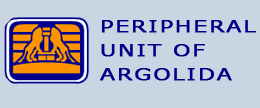Anyfi
|
Anyfi is actually, the main entrance of the new Kallikratis Municipality of Nafplio from Athens via the new road of antiquities, Mycenae, Nafplio. It is a village buried in the orange groves and naturally the cultivation of orange is the main occupation of most residents. It is situated at the crossroads, east and north of Argos and Nafplio, with a distance of 7 & 12 km respectively, at an altitude of 30 meters from the sea, and it had 898 inhabitants according to the 2001 census. |
||
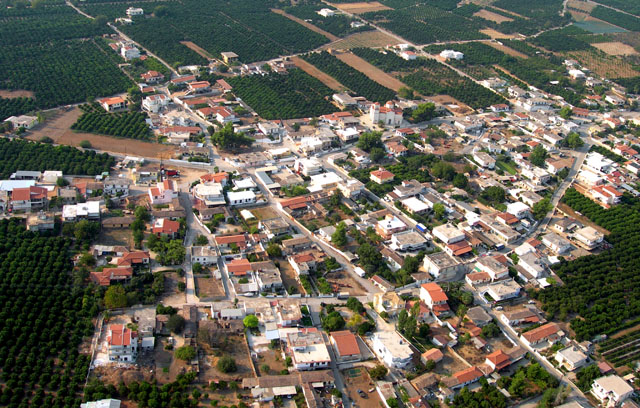 |
||
| Aerial view of Anyfiou | ||
History - Origins - Names |
||
| |
||
| In the area where today the settlement is built, there seems to be no more ancient settlement, as there not have been some traces showing some earlier habitation. Between the location called 'Desi' and this called 'Chasna "east of the village, until a few years ago, there was visible ruins of churches dedicated to St Kiriaki (the name of "Cine Ntializa " derives from this church, which in Greek means Saint Kiriaki) and tiles, highlighted by plowing the land there, suggesting the possible pre-existent, unknown settlement from the Byzantine period.
The first historical mention of the village is in the inventory Grimani, census carried out the orders of the Venetian Governor of Peloponnese F.Grimani, during the years 1699-1700, and it is considered by historians the most trusted until then. In the census, the village listed as Gnyfi, belonging to the province (territorio) of Nafplio, with 147 inhabitants, the largest (according to census) villages of the plain of Argolida prefecture. |
||
| The lack of prior reference to a document or Ottoman register combined with the first mention of the settlement in the census Grimani leads to thought-and most likely-concluded that the settlement with the Latin name Gnyfi, as indicated in the census, is delayed installation of Arvanites in last decades of the 17th century. (1660-1680). The village's name pronounced then Nioufi as the Latin letter G in front of the N, and Y following, clearly suggests. It has not been possible so far to clearly attribute the origin and meaning of the word either referring to the Greek language or Arvanite language.
The residents of Anyfi, there, believe (relying on oral traditions) that the name of the village is related to the Greek word "bride" or "nymph", due to the proximity of the village to the ancient Heraion, which is located approximately 2 kilometres to the north. Archaeologist John Pikoulas in his book "Road Network and Defence Argolido-Korinthias" attributes the name of the settlement in the Turkish word Anifa, meaning "camping place". |
|
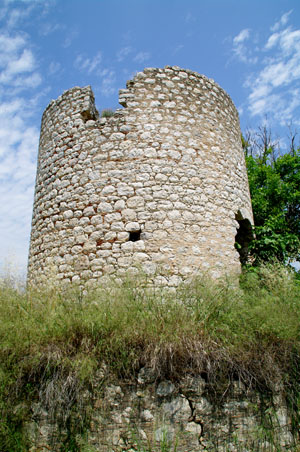 Old flourmill |
The initial location of Arvanites from the last decades of the 17th century was certainly reinforced by Arcadian families, both before and after the revolution of 1821, but also by refugees of Asia Minor or islanders in later times. The geographer Anthony Miliarakis in 1885 made a pilgrimage and came across the prior county Argolidokorinthias. In his book, published in 1886, entitled Geography Politics of Argolida and Corinthia, he indicates the existence of the village Anyfi, and the inhabitants are Albanians as he purports, that speak the dialect Arvanite. |
||
|
The truth is that the original inhabitants of the settlement were bilingual, speaking initially Arvanitika and then Arvanitika and Greek, based on a need to communicate with the large urban centres of Argos and Nafplio and with neighbouring villages, where the Greek element was intense. In the mid 1930s, Arvanite language was abandoned and old men or old women know some words, phrases in Arvanite language, reminiscent of the past. Among the oldest families in the village are: Kollias (currently Mitrokollias) Yiannatsis-Silis (currently Mitrosilis) Koliavanis (currently Kolivanis) Gkatsis and Stergios (Stergiou today). Arcadian families, who settled early (late 18th-early 19th century) the settlement are Hatzis (currently Hatzopoulos) and Karabis. In agrarian periphery of the settlement, both Greek and Arvanite names were observed, another example of bilingualism of its residents. So, we have sites with names like Variza, Baro, Ntrassa, Malimpardi, Cine Ntializa (Saint Kiriaki), Limiko, Chazna, Mnimata, Damnes (Daphnes), Spetzoulia Tzachmetia, Trimeri, Lemona, Sotires, Tourkostrata. It should be noted that during the initial separation of the Greek territory into townships immediately after the revolution of 1821, namely the year 1834, Anyfi was renamed as Prosimni (due to proximity to the ancient Greek city Prosymna) and it was the seat of the newly established municipality Prosimni (Municipality Class C), along with the settlements Dussia (Exohi today), Bardi (currently Amygdalitsa) Avdimpei (currently Iraio) and Plataniti. The municipality was abolished in the year 1837, the village obtained again his name and it was incorporated into the municipality of Midea based on Mermpaka (now Holy Trinity). |
||
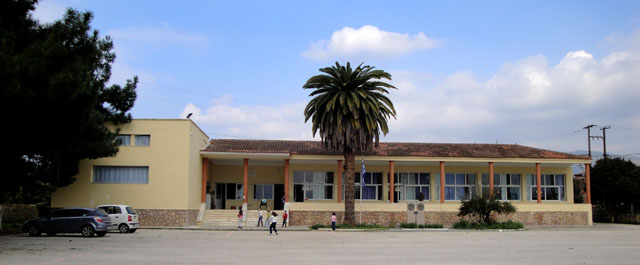 |
||
| 1st Angelopouleio Primary School (The name is borrowed from two benefactors of the village and from founders of Angelopouleio Foundation, Andrianos Angelopoulos and his wife Marigoula) |
||
| Churches - Holidays | ||
|
In the periphery of the village lies the Byzantine church of the Transfiguration of the Saviour at the place named "Saviors" which is a temple rather of the late 11th AD century. More information about JN Metamorphosis can be found in the "Archaeological Sites - Points of Interest" The main church, which is the metropolis of the village, is dedicated to Saint Demetrius and it was built in the late 1920s. In the upper neighbourhood, Upper Quarter (Mahalas), as it is said by residents of Anyfi, lies the oldest church, which was the old cathedral of the town, dedicated to the Annunciation of the "Woman bearing God" (Virgin Mary-Vagelistria for the locals). The cemetery of the village tending to Boudia (currently Hera), enclosing the oldest temple of the village (the original building does not currently exist, since the decade of 30-40 was reconstructed in its present form), is dedicated to St. Nicholas the New, whose memory is celebrated on 9 May, so the residents of Anyfi region call it by Saint-Nicholas. |
||
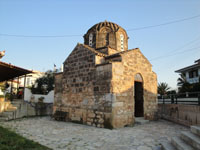 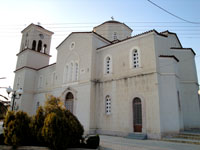 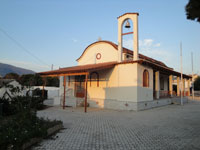 Church of Transfiguration of Christ Church of St. Demetrios Church of Annunciation of Mary |
||
|
The church of the Ascension of Christ, located on the road that connects the New Heraion with Anyfi, and the Church of The Assumption in Plataniti are very important churches of the village. More information about Churches can be found in the "Archaeological Sites - Points of Interest" |
||
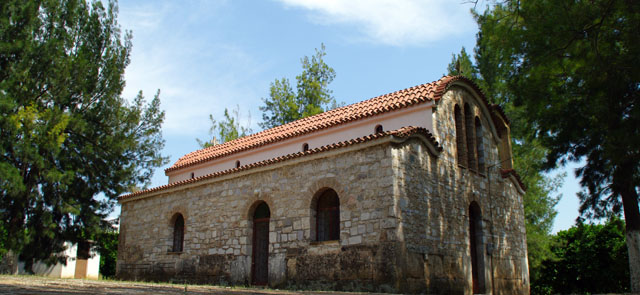 |
||
| Church of Ascension of Christ |
||
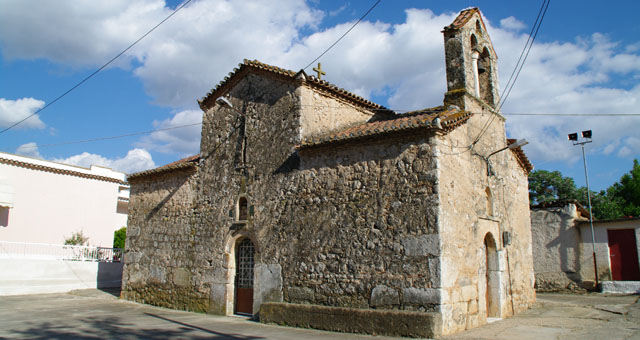 |
||
| Church of Assumption |
||
| Personalities | ||
| The Anyfi is home of the great benefactor Andrianos Angelopoulos, whose large donations, helped majestic and beautiful schools to be built in the village (and the surrounding villages Chonika, Poulakida, Mermpaka). The Anyfi is also home of many artists such as Evangelos (Vangelis) Gatsis with significant support in folk song. |
||
| Social- Sports - Associations | ||
|
In the village, there is the active athletic football club "Pananyfiakos DP" already since the year 1956 as a continuation of the football team "Asteras of Anyfi" already existing in the year 1928. The athletic football club The Cultural Association "May Nicholas' remains dormant in recent years. In the village there are two agricultural cooperatives and two large packing fresh produce. In contemporary Anyfi, a declining population status, an aging population and an extensive influx of economic migrants are simultaneously observed, general symptom of villages in the region and generally the Greek countryside. |
||
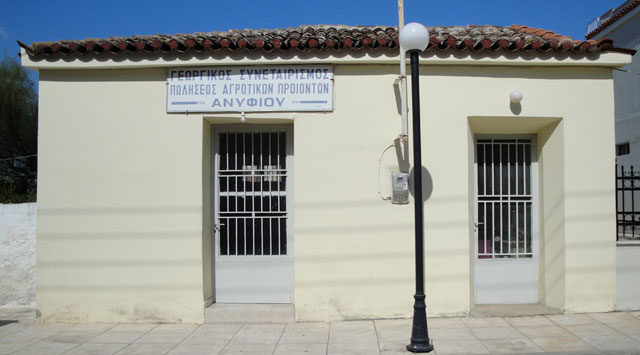 |
||
| Building Agricultural Cooperative of Anyfi |
||
| Central Square Anyfiou (Lat: 37.659804570931996, Long: 22.789018750161517) | ||



